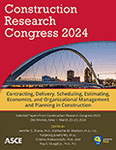Value for Money-Based Project Selection Framework Using Multi-Attribute Utility Theory
Publication: Construction Research Congress 2024
ABSTRACT
Multi-attribute utility theory (MAUT) is a non-monetary approach used to quantify the difference between distinct alternatives considering decision-makers’ preferences to outcomes by assigning utility measures for each alternative. The main objective of using MAUT when evaluating different alternatives is to achieve value for money (VFM), meaning the best possible results based on the money spent. This paper describes the development of a decision-making framework proposed to assist the Florida Department of Transportation (FDOT) with selecting contractor compensation provisions in resurfacing design-bid-build (DBB) projects. The framework facilitates the trade-offs among four decision objectives, if satisfied, to demonstrate value-for-money in FDOT resurfacing investments. The model is illustrated through a hypothetical resurfacing project. The development of the model includes defining four decision objectives. Six measures were proposed to evaluate the level of achievement of the four decision objectives.
Get full access to this article
View all available purchase options and get full access to this chapter.
REFERENCES
Almutairi, A., et al. (2022). A methodology of critical evaluation of the contract selection process used in the construction industry of Kuwait. E3S Web of Conferences, EDP Sciences.
Antoniou, F., and G. Aretoulis. (2019). “A multi-criteria decision-making support system for choice of method of compensation for highway construction contractors in Greece.” International Journal of Construction Management 19(6): 492–508.
Baloi, D., and A. D. Price. (2003). “Modelling global risk factors affecting construction cost performance.” International Journal of project management 21(4): 261–269.
Barnett, C., et al. (2010). “Measuring the Impact and Value for Money of Governance & Conflict Programmes.”, Hove: Itad.
Chelst, K., and Y. B. Canbolat. (2011). Value-added decision making for managers, CRC Press.
El-Abbasy, M. S., et al. (2020). “Finance-based scheduling multi-objective optimization: Benchmarking of evolutionary algorithms.” Automation in Construction 120: 103392.
Emmi, A., et al. (2011). Value for money: Current approaches and evolving debates. London, UK: London School of Economics, May 14.
Fleming, F. (2017). Value for Money. betterevaluation.org.
Frenkel, J. A. (2019). A monetary approach to the exchange rate: doctrinal aspects and empirical evidence. Flexible Exchange Rates and Stabilization Policy, Routledge: 68–92.
Gerçek, H., et al. (2004). “A multiple criteria approach for the evaluation of the rail transit networks in Istanbul.” Transportation 31(2): 203–228.
Habibi, M., and S. Kermanshachi. (2018). “Phase-based analysis of key cost and schedule performance causes and preventive strategies: Research trends and implications.” Engineering, Construction and Architectural Management.
Heald, D. (2003). “Value for money tests and accounting treatment in PFI schemes.” Accounting, Auditing & Accountability Journal 16(3): 342–371.
ICAI (The Independent Commission for Aid Impact). (2011). ICAI’s Approach to Effectiveness and Value for Money. The Independent Commission for Aid Impact.
Iniestra, J. G., and J. G. Gutiérrez. (2009). “Multicriteria decisions on interdependent infrastructure transportation projects using an evolutionary-based framework.” Applied Soft Computing 9(2): 512–526.
Kelly, J., et al. (2014). Value management of construction projects, John Wiley & Sons.
Khalafalla, M. (2019). Cost-Duration-Based Lump Sum Project Selection Framework Using Stochastic Methods for Design-Bid-Build Resurfacing Projects.
Khalafalla, M., and J. Rueda-Benavides. (2018). “Unit Price or Lump Sum? A Stochastic Cost-Based Decision-Making Tool for Design-Bid-Build Projects.” Transportation Research Record: 0361198118758052.
Khalafalla, M., and J. A. Rueda. (2020). “Methodology to assess the impact of lump-sum compensation provisions on project schedules.” Journal of Management in Engineering 36(4): 04020028.
Mateo, J. R. S. C. (2012). Multi-attribute utility theory. Multi Criteria Analysis in the Renewable Energy Industry, Springer: 63–72.
Olatunji, S. O., et al. (2017). “Achieving value for money (VFM) in construction projects.” Journal of Civil and Environmental Research 9(2).
Park, J., and Y. H. Kwak. (2017). “Design-Bid-Build (DBB) vs. Design-Build (DB) in the US public transportation projects: The choice and consequences.” International Journal of project management 35(3): 280–295.
Rueda-Benavides, J., et al. (2023). “Probabilistic cost-based decision-making matrix: IDIQ vs. DBB contracting.” Construction Management and Economics: 1–15.
Rueda-Benavides, J., et al. (2022). “Cross-asset prioritization model for transportation projects using multi-attribute utility theory: a case study.” International Journal of Construction Management: 1–10.
Tsamboulas, D. A. (2007). “A tool for prioritizing multinational transport infrastructure investments.” Transport Policy 14(1): 11–26.
Zardari, N. H., et al. (2015). Weighting methods and their effects on multi-criteria decision making model outcomes in water resources management, Springer.
Information & Authors
Information
Published In
History
Published online: Mar 18, 2024
Authors
Metrics & Citations
Metrics
Citations
Download citation
If you have the appropriate software installed, you can download article citation data to the citation manager of your choice. Simply select your manager software from the list below and click Download.
